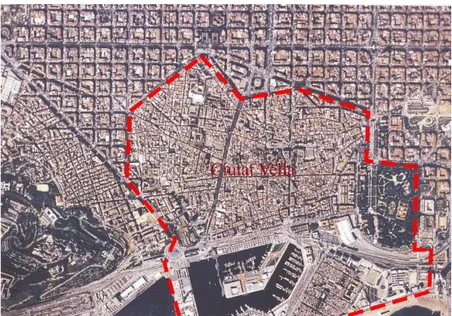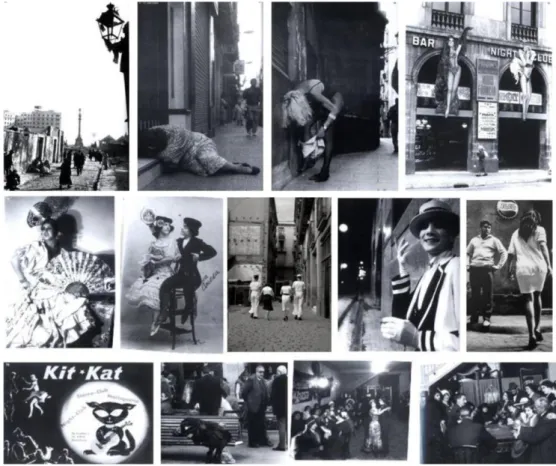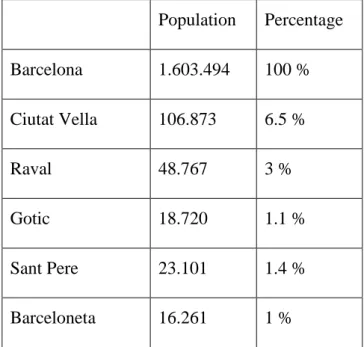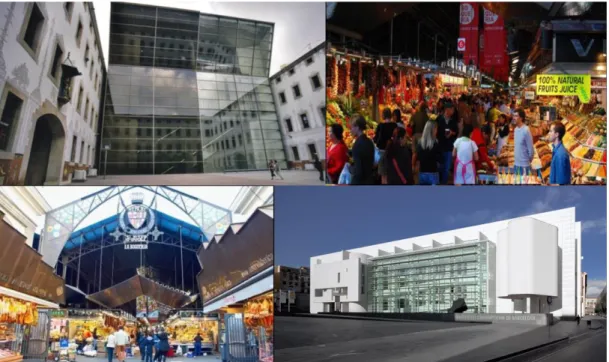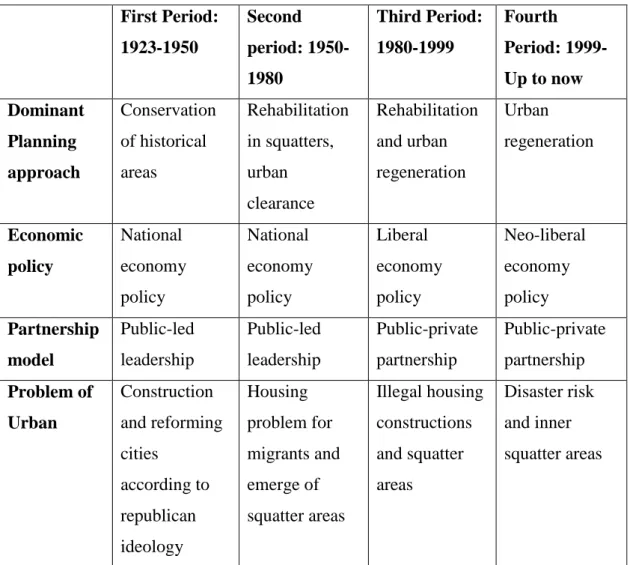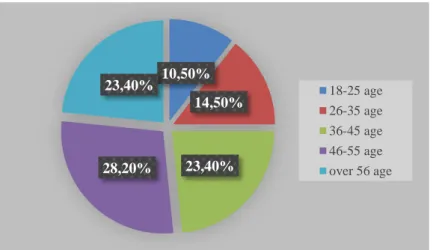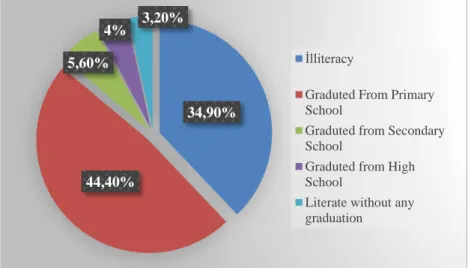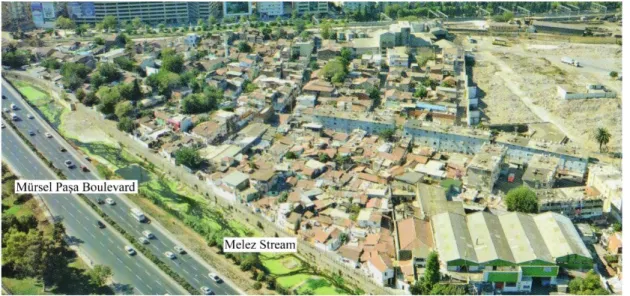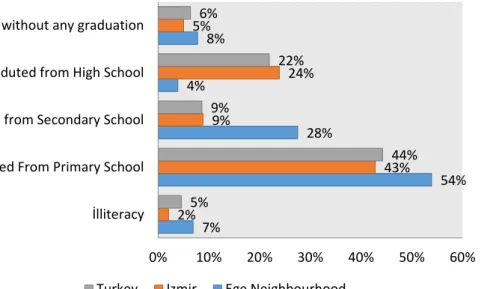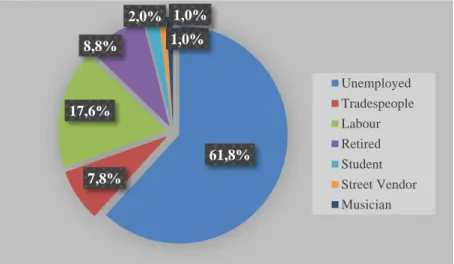M.Sc. THESIS
JUNE 2016
URBAN REGENERATION STRATEGIES FOR SUPPORTING SOCIAL SUSTAINABILITY OF ROMA COMMUNITY: IZMIR-EGE NEIGHBOURHOOD URBAN REGENERATION PROJECT
Thesis Advisor: Asst. Prof. Dr. Yakup EGERCİOĞLU
IZMIR KATIP CELEBI UNIVERSITY GRADUATE SCHOOL OF SCIENCE AND ENGINEERING
Mehmet Melih Cin
IZMIR KATIP CELEBI UNIVERSITY GRADUATE SCHOOL OF SCIENCE AND ENGINEERING
JUNE 2016
URBAN REGENERATION STRATEGIES FOR SUPPORTING SOCIAL SUSTAINABILITY OF ROMA COMMUNITY: IZMIR-EGE NEIGHBOURHOOD URBAN REGENERATION PROJECT
M.Sc. THESIS Mehmet Melih CİN
(130201016)
Department of Urban Regeneration
HAZİRAN 2016
İZMİR KÂTİP ÇELEBİ ÜNİVERSİTESİ FEN BİLİMLERİ ENSTİTÜSÜ
ROMANLARIN SOSYAL SÜREKLİLİKLERİ DESTEKLEYİCİ KENTSEL DÖNÜŞÜM STRATEJİLERİ: IZMİR-EGE MAHALLESİ KENTSEL
DÖNÜŞÜM PROJESİ
YÜKSEK LİSANS TEZİ Mehmet Mel�h CİN
(130201016)
Kentsel Dönüşüm Ana B�l�m Dalı
v
Asst. Prof. Dr. Dilek MEMİŞOĞLU ... İzmir Katip Çelebi University
Thesis Advisor : Asst. Prof. Dr. Yakup EGERCİOĞLU ... İzmir Katip Çelebi University
Jury Members : Prof. Dr. Ebru ÇUBUKÇU ... Dokuz Eylül University
Mehmet Melih Cin, a M.Sc. student of IKCU Graduate School of Science and Engineering, successfully defended the thesis entitled “URBAN REGENERATION STRATEGIES FOR SUPPORTING SOCIAL SUSTAINABILITY OF ROMA
COMMUNITY: IZMIR-EGE NEIGHBOURHOOD URBAN
REGENERATION PROJECT”, which he prepared after fulfilling the requirements specified in the associated legislations, before the jury whose signatures are below.
Date of Submission : 13 May 2016
vii
ix
FOREWORD
I would like to thank the following people who helped me build this study.
I would like to thank my parents Belgin Cin and Mesut Cin for their support and trust in every area of my life. I would also like express my gratitude to my sister Dr. Firdevs Melis Cin for being supportive during this research.
I am also grateful my supervisor Yakup Egercioğlu for his guidance and being a source aspiration.
Lastly, I am in debt to Özgecan Zafer and Semih Kurt for their support during the fieldwork in Izmir. I would like to thank head of NGO in Ege neighborhood Seyfi Yılmaz and head of Ege neighborhood Kemal Dursun for their support in the field and for providing me with the necessary information about the community. Last but not least, my special thanks go to Dr. Maria Papadimitriou for helping me research in Roma Community during my studies in Greece.
xi TABLE OF CONTENTS Page FOREWORD ... ix TABLE OF CONTENTS ... xi ABBREVIATIONS ... xiv
LIST OF TABLES ... xvi
LIST OF FIGURES ... xviii
SUMMARY ... xx
ÖZET ... xxii
1. INTRODUCTION ... 1
1.1 The Scope and Aim of the Study: Thesis Statement ... 1
1.2. Research Question ... 4
1.3. Methodology of the Research... 4
1.4. The Content of the Study: Chapters ... 6
2. CONCEPTUALIZATION OF URBAN AND THE CONCEPT OF RIGHT TO THE CITY ... 8
2.1. Introduction ... 8
2.2. Urban and Urbanization ... 8
2.3. Urban Regeneration ... 10
2.4. Forms of Urban Renewal ... 11
2.5. Actors and Partnership Models in Urban Regeneration Process ... 13
2.6. Social Sustainability ... 14
2.7. Gentrification ... 16
2.8. Right to the City ... 17
2.9. Conclusion ... 22
3. URBAN REGENERATION PROJECTS ... 23
3.1. Introduction ... 23
3.2. Urban Regeneration in the World ... 23
3.2.1. Barcelona- Ciutat Vella urban regeneration project ... 27
3.3. Urban Regeneration in Turkey ... 32
3.3.1. Policies about urban regeneration in Turkey (Legal basis of urban regeneration) ... 37
3.3.1.1. Renovation, conservation and use of dilapidated historical and cultural immovable assets act... 37
3.3.1.2. Municipality act ... 38
3.3.1.3. Regeneration of disaster risk areas act ... 39
3.3.1.4. Metropolitan municipality acts ... 39
3.4.Roma People ... 40
3.5. Sulukule Urban Regeneration Project ... 42
3.5.1. Demographic structure of Sulukule before the urban regeneration project ... 44
3.5.2. Urban regeneration process ... 48
3.6. Conclusion ... 49
4. DEFINING CRITERIA FOR SUSTAINABLE URBAN REGENERATION 51 4.1. Declarations ... 51
4.1.1. The European Declaration of Urban Rights ... 51
4.1.2. European Charter for the Safe-Guarding of Human Rights ... 52
xii
4.2. The List for Rights Analysis... 54
4.2.1. Principle of equality of rights and non-discrimination ... 54
4.2.2. Right of (public) information ... 55
4.2.3. Right to education ... 55
4.2.4. Right to work ... 56
4.2.5. Right to culture ... 56
4.2.6. Right to house... 57
4.2.7. Right to health ... 58
4.2.8. Right to healthy environment and leisure ... 59
4.2.9. Right to public transportation and urban mobility ... 59
4.2.10. Right of political participation (right of association assembly and demonstration) ... 60
4.3. Conclusion ... 61
5. CASE OF EGE NEIGHBORHOOD ... 62
5.1. Demographic Structure of Ege Neighborhood ... 64
5.2. Urban Regeneration Project Proposal ... 70
5.3. Analysis of the Urban Regeneration Project ... 72
5.3.1. Right to education ... 72
5.3.2. Right to work ... 74
5.3.3. Right of public information ... 75
5.3.4. Right to culture ... 76
5.3.5. Right to house... 78
5.3.6. Right to healthy environment and leisure ... 84
5.3.7. Right to public transportation and urban mobility ... 86
5.3.8. Right to health ... 88
5.3.9. Principle of equality of rights and non-discrimination ... 88
5.3.10. Right to political participation... 89
5.4. Conclusion ... 90
6. CONCEPTUALIZATION AND ANALYSIS OF PARTICIPATION ... 96
6.1. Introduction ... 96
6.2. Historical Background and Conceptualization of Citizen Participation ... 96
6.2.1. Participation frameworks ... 98
6.2.1.1. Ladder of participation- Arnstein ... 98
6.2.1.2. Active participation framework- OECD ... 100
6.2.1.3. Spectrum of public participation-IAP2 ... 101
6.2.1.4. Changing views on participation- Pedro Martin ... 101
6.3. Participation Models ... 102
6.3.1. Design participation model ... 102
6.3.2. Comparison of three type of participation model... 104
6.4. Tools for Relation Between Public and Authorities ... 105
6.4.1. To inform public... 105
6.4.1.1. Meetings ... 105
6.4.1.2. Media and internet usage ... 106
6.4.2. To get information from public ... 108
6.4.2.1. Group meetings ... 108
6.4.2.2. Beneficiary assessment ... 110
6.4.2.3. Workshops ... 111
6.4.2.4. Virtual participation tools: ... 112
6.4.2.5 SARAR ... 113
xiii
6.6. Participation Structure Proposal for the Neighborhood ... 118
6.7. Conclusion ... 124
7.CONCLUSION ... 125
REFERENCES ... 130
APPENDIX ... 139
xiv
ABBREVIATIONS
CLRAE : Council of Europe's Standing Conference of Local and Regional Authorities of Europe
ECSHR : European Charter for the Safe-guarding of Human Rights EDUR : The European Declaration of Urban Rights
EU : European Union
IAP : International Association for Public Participation
OECD : Organization for Economic Cooperation and Development TOKI : Mass Housing Administration
UN : United Nation
UNESCO : United Nations Educational, Scientific and Cultural Organization WCRC : World Charter for the Right to the City
xvi
LIST OF TABLES
Page Table 3.1: Population of Barcelona and Ciutat Vella (Foment Ciutat) ... 30 Table 3.2: History of urban regeneration in Turkey ... 37 Table 5.1: Analysis of urban regeneration project ... 93
xviii
LIST OF FIGURES
Page
Figure 3.1: Ciutat Vella ... 27
Figure 3.2: Raval district in 1990s (Küçük, H. A) ... 28
Figure 3.3: Ciutat Vella’s Neighborhoods (Foment Ciutat) ... 29
Figure 3.4: MACBA Museum, CCCB Culture Center, Sant Josep Boqueria Market 31 Figure 3.5: Gender ratio of responders ... 45
Figure 3.6: Age group of responders ... 45
Figure 3.7: Education Level ... 46
Figure 3.8: Family Size ... 46
Figure 3.9: Job occupations ... 47
Figure 3.10: Property Ownership ... 48
Figure 3.11: Rent Prices ... 48
Figure 5.1: Location of Ege neighborhood ... 62
Figure 5.2: Ege Neighborhood ... 63
Figure 5.3: Responder’s Gender ... 65
Figure 5.4: Responders’ ages ... 65
Figure 5.5: Responders’ education level ... 65
Figure 5.6: Comparison of education level ... 66
Figure 5.7: Job occupation of responders... 67
Figure 5.8: Job occupations according to gender ... 68
Figure 5.9: Property ownership ... 68
Figure 5.10: Detached houses in Ege neighborhood ... 69
Figure 5.11: Apartment blocks in Ege neighborhood ... 70
Figure 5.12: Ege neighborhood urban regeneration project ... 71
Figure 5.13: Ege neighborhood urban regeneration project ... 71
Figure 5.14: Ege Neighborhood Urban Regeneration Project office ... 75
Figure 5.15: NGO’s Office at the Neighborhood ... 77
Figure 5.16: The neighborhood square in the project ... 78
Figure 5.17: Housing blocks design of the project... 79
Figure 5.18: Three parts of residential areas ... 82
Figure 5.19: Plan of housing units ... 83
Figure 5.20: Dirty roads ... 85
Figure 5.21: Noise pollution and smell of river ... 85
Figure 5.22: Underpass which connect the neighborhood to city center ... 87
Figure 5.23: Circulation path of vehicles and pedestrian circulation path ... 87
Figure 5.24: Complains on lack of health facilities ... 88
Figure 5.25: Participation level of meetings ... 90
Figure 5.26: Strengths of the neighborhood ... 91
Figure 5.27: Decision of staying in the neighborhood after the project ... 92
Figure 6.1: Arnstein’s ladder of citizen participation ... 99
Figure 6.2: Active participation framework ... 100
Figure 6.3: Spectrum of public participation ... 101
Figure 6.4: Pedro Martin’s view on participation ... 102
Figure 6.5: Conventional participation process ... 104
Figure 6.6: Participatory participation process ... 104
Figure 6.7: Consensus group based participation ... 105
xix
Figure 6.9: Informing the citizens ... 116
Figure 6.10: Satisfaction from the project... 116
Figure 6.11: Participation to the project with their thoughts ... 117
Figure 6.12: Citizen’s ideas’ impact on the project ... 117
Figure 6.13: Satisfaction from existing participation model ... 118
xx
URBAN REGENERATION STRATEGIES FOR SUPPORTING THE SOCIAL SUSTAINABILITY OF ROMA COMMUNITY: IZMIR-EGE
NEIGHBOURHOOD URBAN REGENERATION PROJECT SUMMARY
Urban regeneration greatly affect marginalized groups both across the world and in Turkey and therefore it is a hot topic in the public discussions of urban context. One of those marginalized groups are Roma communities. Their neighborhoods, particularly inner urban areas, face social and physical decay due to discrimination against Roma communities. To address these social and physical problems, urban regenerations projects have been launched in Turkey in the name of improving life standards of Roma citizens. However, implementations could not go further than improving physical conditions of the neighborhood. Social, economic and environmental aspects of the regeneration projects have been ignored. Also, inhabitants could not be part of the urban regeneration projects and decision making process. These deficiencies caused gentrification of society. These widespread implementations and their outcomes bring out question of how to prevent gentrification on Roma community. Therefore, this study aims to analyze urban regeneration project in Ege neighborhood in Izmir from Henri Lefebvre’s right to the city concept In doing so, the study draws its data from 102 questionnaires and 9 interviews. The study first analyses the extent Ege neighborhood urban project enables the inhabitants to use and access their right of city. Then, it proposes a participation model to prevent gentrification caused by urban regeneration models.
xxii
ROMANLARIN SOSYAL SÜREKLİLİKLERİ DESTEKLEYİCİ KENTSEL DÖNÜŞÜM STRATEJİLERİ: IZMİR-EGE MAHALLESİ KENTSEL
DÖNÜŞÜM PROJESİ ÖZET
Türkiye’de ve Dünya’da ki kentsel dönüşüm uygulamaları kentlerde bulunan marjinalleşmiş, dezavantajlı grupları hedef almaktadır. Kentsel bağlamda bu gruplara yapılan uygulamaların tartışmaları güncelliğini korumaktadır. Bu gruplar arasından en çok öne çıkanları ise Romanlara uygulanan kentsel dönüşüm uygulamalarıdır. Özellikle, romanlara yapılan ayrımcılıklar, yaşadıkları alanların sosyal ve fiziki çöküntü alanlarına dönüşmeleri neden olmuştur. Bundan dolayı, yaşadıkları mahalleler kentsel dönüşüm uygulamalarının hedefi haline gelmiştir. Kentsel dönüşüm uygulamalarında sosyal ve fiziki yıpranmaları önlemek ve geliştirmek amaçlanmıştır. Ama Sosyal, çevresel ve ekonomik boyutları göz ardı edilerek, uygulamalar sadece fiziki standartları artırmaktan öteye gidememiştir. Ayrıca uygulamalarda kentlinin ihtiyaç ve beklentileri dinlenmemiş bu da projelerin kentlinin yaşam standartlarını artırmaktan çok Romanların yaşadığı alanların soylulaştırılmasına hizmet etmiştir. Romanlar üzerine yapılan kentsel dönüşüm uygulamaları ve sonuçları, toplumun soylulaştırılmasının nasıl önlenebileceği sorusunu doğurmuştur. Bundan dolayı, bu çalışmanın amacı Ege mahallesi kentsel dönüşüm projesini Lefebvre’nin kent hakkı ve uluslararası bağlamda yapılan kent hakları anlaşmalarına göre inceleyip, sosyal devamlılığı, proje aşamasında sağlayıcı stratejileri ortaya koymaktır. Bu bağlamda, Ege mahallesinde 102 kişi ile anket çalışması ve toplamda 9 kişi ile mülakat gerçekleştirilmiştir. Arazi çalışmaları kentsel dönüşüm projesindeki sorunları tespit etmemizi sağlayıp, mevcut projedeki katılım hakkını incelememize yardımcı olaraktır. Sonuç olarak, mevcutta saptanan eksiklikler üzerinden, Roman toplumun şartlarına uygun, soylulaştırılmasını önleyici, toplumun fikirlerinin kara alma mekanizmasında yer alacağı bir katılım modeli önerilmektedir.
1
1. INTRODUCTION
Urban Regeneration is a vision and an action which provides permanent solutions to economic, physical, social and environment problems of urban areas. It aims to revive deteriorated and decayed urban areas.
Until 1980s, urban regeneration implementations were applied by governments. This is because governments had national economies and therefore they had a provider role in urban area. However, after 1980s, shift to liberal economies necessitated governments to adopt regulatory and practicability role. This change in the role included different actors such as local authorities, private companies, landlords, tenants and non-governmental organizations in urban regeneration projects and it is defined as community based urban regeneration process as it includes all stakeholders. However, the community based urban regeneration process is not being applied widely and the cases and projects in Izmir are not an exception. Therefore, this thesis focuses on Izmir Ege Neighborhood case and scrutinizes the participation and city rights mechanisms employed in the project.
1.1 The Scope and Aim of the Study: Thesis Statement
Restructuring of urban space appeared as an alternative way to absorb the surplus capital in the last century to overcome the global economic crisis. Thus, urban space emerged as a new sector to invest in. Therefore, emergence of capitalist movement towards cities led to rapid development of urban areas. This rapid development was accelerated by migration from rural to urban. Correspondingly, Turkey, as a lately capitalist country, has also experienced the same movement within its own circumstances. After 1950s, by rapid development in industrial sector emerged migration to cities which triggered need for housing. However policies and investment of the public sector was not sufficient to respond this need. Therefore, squatters were constructed by migrants. So urbanization experience of cities in Turkey started with construction of squatter housings. This was followed by a number policies legalizing squatter housing. However, with the adaption of neo-liberal policies in 1980s, squatters
2
started to be seen and accepted as “problematic” areas of urban texture as they lacked public services, infrastructure, and social facilities. In the reality, squatter areas have less space to merchandise. In other words, monetary value of the space is not as important as use value of the space. Therefore, regeneration of squatter areas can provide an opportunity for the capital to improve monetary value of space. In align with the neo-liberal policies, Turkey’s urban context experience in the last decade brought intervention of urban areas by tool of urban regeneration project respectively first in Ankara and then in Istanbul These projects were mainly applied to squatter areas of the city where marginalized citizens lived. Marginalized people are who live at the city center, facing with social exclusion such as Roma community. Also, due to social exclusion, they have difficulties to find a job, therefore, people have low economic profile. Romani people are one of the main groups who faced with urban regeneration projects. Due to physical and social decay of Romani settlements, values of the lands they live in were lower than its nearby lands, so, urban regeneration projects on these settlements provided an opportunity for capital to impose the land. On the other hand, projects’ aims were declared as to improve conditions of the area for the good of inhabitants of the neighborhood. However, in the world-wide known example of Sulukule, it caused gentrification of the area and loss of Roma identity and culture.
Within this context, social sustainability in urban regeneration should be handled to protect cultural and identical existence of Roma community. To analyze conditions and to establish a social sustainable urban regeneration model, this thesis focuses on Izmir Ege neighborhood as a case study.
In this respect, the research begins with the review of concepts which are related to urban regeneration and social sustainability such as; city, urbanization urban regeneration types. It continues with definition and conceptualization of notion of right to the city drawing from different scholars’ thoughts and ideas and offer a definition based on from the work of David Harvey and Henry Lefebvre. Right to the city term has a vital role in preventing gentrification and achieving social sustainable regeneration. Therefore, it is the main pillar of the research.
The thesis has two dimensional analysis based on the right to the city concept. First dimension of the analysis of Ege neighborhood urban regeneration project proposal focuses on international right to the city instruments which were signed by member
3
countries of United Nation. These instruments are defined as advance version of human rights declaration and they emerge from Lefebvre’s notion of right to the city. Instruments can be defined as a more detailed, structured and robust version of the notion. Thus, drawing from three declarations, ten criteria are defined to analyze the urban regeneration project. Second dimension of the research is to establish and propose a participation model in response to analyzed deficiencies in urban regeneration project. In so doing, the uniqueness of the case and socio-cultural structure were taken into consideration.
The main argument of the thesis is that urban regeneration projects is likely to cause gentrification and unlikely to protect community culture of marginalized groups if they are not conducted with respect to right to the city, which provides a framework of for social sustainability. Thus the thesis, by using the right to the city concept, also looks into physical, environmental and economical cases of the neighborhood. Lastly, the research aims to provide participatory model that would increase sense of belonging of inhabitants and satisfaction level from the project.
The reason of choosing Izmir Ege neighborhood urban regeneration project as a case study is due its being inner city area and settlement for Roma community. The project is in the stage of design process. Implementation of the project has not started yet. Therefore, there is still an opportunity to prevent gentrification of the community and to protect Roma identity in the neighborhood.
Additionally, examining one completed urban regeneration practices from international (Barcelona case) and national context (Sulukule case) will also and provide opportunities to draw a comparative analysis and benefit from experiences of these projects while establishing a participation model. Therefore, Barcelona- Ciutat Vella and Istanbul-Sulukule urban regeneration projects are also presented and examined in the thesis. The common point of these two projects are they were both applied on marginalized people. While Barcelona case was defined as sustainable and positively resulted urban regeneration practices, Sulukule case can be defined an as unsuccessful project due to gentrification.
This aspires to provide a better understanding of Ege neighborhood case by applying right to city notion and by drawing experiences from previous urban regeneration cases
4
to establish a participatory model in decision making in order to achieve a social sustainable urban regeneration.
1.2. Research Question
Urban regeneration has become an important case for Turkish urban context since the beginning of 2000s. Urban regeneration is being used as a tool to improve physical and social structure of cities and to provide adequate housing standard for citizens. On the other hand, the term was using all over the world for last century. Especially European countries implemented many urban regeneration at cities to improve life quality, to provide public services, to improve social and physical conditions of cities and to enhance economical activates to compete in a global context.
As, urban regeneration concept became popular in Turkey with the aim of improving the condition in inner cities. In last decades many project implemented in urban areas. However, main focus areas of these implementations concentrated on city center’s deteriorated areas where marginalized or disadvantages groups live with low economical profile. Among these disadvantages groups, Roma community is one of the main focus groups in urban regenerations. Unfortunately, projects applied in Roma communities did not result with improvement in their life quality, on the contrary, it caused gentrification and eviction from their lands. Projects implementation on disadvantages groups show that project aims and outcomes are different. At the end of the project, urban texture of the area and cultural structure are altered totally. Considering that urban regeneration projects still continues in Roma communities, the thesis aims to answer following research questions:
1) To what extent does current Ege neighborhood project address to the inhabitants’ city rights and aim social sustainability of the Roma community?
2) How gentrification of inhabitants can be prevented by citizen participation in decision making?
1.3. Methodology of the Research
This research has been accomplished by using wide range of qualitative and quantitative data collection techniques. The methodological tools used in this research are; questionnaires, interviews and observations. Methodology has stimulated a pave
5
to understand circumstances of citizens and structure for decision making in urban regeneration project in Ege neighborhood. In this scope, historical, socio-economical background of the neighborhood and relations between inhabitants, NGOs and local authority were analyzed.
The study is located at the intersection of urban regeneration, social sustainability, Roma community and right to the city.
I have conducted field work in the neighborhood between June 2014 to 2016 April. I visited the field at different times to conduct interviews and questionnaires take photos and make observations. Questionnaires were based on open-ended questions which were applied to randomly selected 105 citizens. However 102 of them were valid for evaluation, 3 of them was invalid due to incoherent responds. Questionnaires were applied through face-to-face communication method due to low profile of literacy. This method also helped to keep inhabitants’ attention to the questions and to achieve more reliable results. To address both men and women’s ideas, the questionnaire was conducted in coffeehouses where men dominated social space and in front of houses which serve as a social space for women to socialize. Also to include different groups’ (in terms of gender and age) ideas in the neighborhood, questionnaires were conducted in different parts of the neighborhood.
The questionnaire also included semi-structured format questions which were asked to randomly selected citizens. I also conducted semi-structured in-depth interviews with different actors of urban regeneration process. Semi-structure questions allowed me to elaborate on the answers of respondents and direct the interview according to their answers. Before conducting the interviews and questionnaires, a pilot study was applied to ensure consistency, the clarity of the questions and reliability. It also aimed to prevent provoking questions against their identity. This test was applied on five people who live in the neighborhood. Then the questions were revised and necessary amendments were made to make sure that my questions addressed necessary points. I conducted in total 9 interviews, with a person who work at metropolitan municipality, head of Ege Neighborhood Urban issues, Culture and Beneficial Association, head of the neighborhood, a street vendor in the neighborhood, a grocery store owner in the neighborhood, a coachman who lives at Ege district, three random inhabitants from three different parts of the neighborhood and an officer from Metropolitan Municipalities’ urban regeneration office. Three random inhabitants’ interview was
6
conducted to understand macro-problems of the area. For instance, people who live next to railways have problem with train and its noise and people who live next to factory have problem with smell of bones. All interviews were recorded except for the interview with urban regeneration officer due to his disapproval of recording. To understand the case from Izmir Metropolitan Municipality’s perspective, more interviews tried to be conduct, however, due to high confidentiality of the project, officers rejected to talk about the project.
As another technique, observation was used to analyze the neighborhood, Roma community, its culture and solidarity of the community. During the fieldworks, I tried to reach different groups such as employed or unemployed people. Therefore, the neighborhood were visited at different times and days such as; working hours, workdays, holidays. These experiences provide me to observe inhabitants’ attitudes, their gathering places and cultural activities. Moreover, I had chances to analyze real effects of the projects in their daily lives.
1.4. The Content of the Study: Chapters
This thesis consists of seven chapters, including introduction and conclusion chapters. The introduction part of the study presents the scope and aim of the study; research question of the thesis; and the methodology.
Chapter two conceptualizes right to the city notion according to Lefebvre’s expressions and scholars’ definitions. Also, the notion examines two key aspects which are right to participation and right to appropriation. These conceptualizations establish basis of this research. Then, the thesis conceptualizes terms related with urban and urban regeneration. Therefore, it defines urban, urbanization, urban regeneration, and gentrification. Then, the thesis examines different forms and partnership models in urban regeneration.
Chapter three examines history of urban regeneration practices in the world under five periods which were divided with regards to the socio-economic context of period and main dynamics of urban regeneration implementation. Also, the chapter analyzes Barcelona-Ciutat Vella urban regeneration case as an example of a successful regeneration in the world context. Then, the chapter continues with Turkey context.
7
Historical background of urban regeneration practices, legal basis of urban regeneration, Roma community and Sulukule case are presented and analyzed. In chapter four, the conceptual framework is provided by drawing from international rights to the city instruments. This framework sets the criteria for analyzing Ege neighborhood urban regeneration project in chapter 5.
Chapter five focuses on Ege neighborhood as a case study. Historical background of the Roma community of the neighborhood is examined. Then according to findings in the fieldwork, demographic structure and the project proposal is analyzed. This chapter shows the extent project proposal addresses citizens’ rights of the city, needs and demands.
Chapter six covers concept of citizen participation and analyzes existing participation model in the neighborhood. Definition of citizen participation, frameworks, models and participation tool are conceptualized. According to this conceptualization, existing participation model is defined and analyzed. Also, findings in field work are used to examine effectiveness of existing participation model and its participation tools. Drawing from the problems in existing participation model, new participation model and participation tools are suggested for neighborhood.
Chapter seven is the conclusion. It offers an analytic review of results, states the contribution of thesis to the literature and lists the limitations. The thesis concludes with recommendations for future implementation.
8
2. CONCEPTUALIZATION OF URBAN AND THE CONCEPT OF RIGHT TO THE CITY
2.1. Introduction
This chapter aims to provide a definition and conceptualization of basic concepts about urban regeneration and forms of urban renewal. Then, chapter introduces the Henri Lefebvre’s right to the city concept as a theoretical framework of this study. The study also situates this concept within broader literature of urban and urban regeneration and draws from other scholars’ work on right to the city to offer a robust understanding of the concept.
2.2. Urban and Urbanization
It is hard to generate a specific definition “urban” as it can differentiate from one country to another or it can be re-defined according to the criteria such as; population size, population density, space, economic and social organizations, economic function, labor supply and demand. On the other hand, there is a confusion between the terms of “city” and “urban”. The term “city” refers to legal description of municipalities, namely, it is an administrative definition for urban.
William H. Fery and Zachary Zimmer (1998:10-11) define urban concept by distinguishing it from rural. Therefore, the difference between urban and rural can be defined according to three elements; ecological element, economic element and social character. Ecological factor covers population size and density. However, this can change for nations. For instance, Denmark considers a population of 250 or greater as an urban whereas India considers population of 5000 and more as an urban. Secondly, economic factor refers to non-agricultural production. Rural areas’ economic activities usually concentrate on agricultural production while urban areas’ economical activities are organized around nonagricultural production. Lastly, social character covers how “the way rural and urban people live, their behavioral characteristics, how they perceive the world, their values” (Frey& Zimmer, 1998:11).
9
Keleş defines urban as “a place where has continuous social development and change, less people dealing with agricultural production, meets requirements of people’s sheltering, transportation, work, relaxation, entertain and has high population density” (Keleş, 1998:75)
According to Alkan, urban is defined for all spaces where people live and do all activities. For Tekeli (2015:20), urban can be defined as “a settlement where non-agricultural production, control on all productions, coordination of distribution and reached level of size, density, heterogeneity and integration”. Indeed, urban is defined differently by all professionals according to their perspectives. For instance, economists define it according to production-consumption relations, geographers define according to population and population movements. Thus, urban covers all definitions which are defined by different professionals and it is an interdisciplinary area of study (Alkan, 1991:960-967).
To conclude, in urban context, urban is defined according to the following criteria (Tekeli, 2015:18):
Production type: it covers non-agricultural production and it can be measured with rate of non-agricultural production in all production types
Size Level: Measured with population size.
Density: Measured with population who live in certain area
Heterogeneity: functionality, and usage of land for different purposes.
Integration: availability of transportation and communication facilities and its density in urban area.
Urbanization, generally, refers to an increasing shift from agrarian to industrial services and distributive occupations (Mandal, 2000). These services and occupational opportunities as a pull factor cause many people to migrate from rural areas to urban areas. These people are stimulated by push factors such as natural disasters, economic stagnant, and poverty. Tekeli (2015:20) defines urbanization as an incensement in rate of non-agricultural production and an incensement in density of controlling and coordinating all productions in a settlement. According to Tekeli (2015:20), urbanization occurs “with incensement in level of size density, heterogeneity and integration in urban”.
10
Keleş (2015:35) argues that urbanization occurs as result of change in social and economic structure of the society. In another words, urbanization is defined as population accumulation process which emerges with development in industrialization and economy and incensement in urban areas. Urban growth occurs with improvement in division of labor, specialization, and alters relations and attitudes in society. After having defined urban and urbanization and its processes of formation, I now present the right to the city concept as it forms the theoretical underpinning of this thesis.
2.3. Urban Regeneration
“Urban regeneration” refers to recreating, renewing or reconstructing existing urban area. It is the reconstruction of certain areas in different manners. According Smith (2002:62) and Roberts (2000:17) urban regeneration means “ comprehensive and integrated vision and action which leads to resolution of urban problems and which seeks to bring about a lasting improvement in the economic, physical, social and environmental conditions of an area that has been subject to change.” They emphasized essential features of urban regeneration with economic, social and environmental conditions. In this sense, Lichfield (1992:19) made more useful definition and offers a “better understanding of the process of decline” and an “agreement on what one is trying to achieve and how”. Donnison (1993:18) defines it as “new ways of tackling our problems which focus in a co-ordinated way on problems and on the area where those problems are concentrated”. Lichfield (1992) and Donnison (1993) argue that urban regeneration concentrates on the problematic areas to sustain improvement. Parallel to these definitions, Sönmez (2005:16) mentions that it is a process to solve social, economic and spatial problems with intervention in the urban area. The most inclusionary urban regeneration is concerned “with the re-growth of economic activity where it has been lost; the restoration of social function where there has been dysfunction, or social inclusion where there has been exclusion; and the restoration of environmental quality or ecological balance where it has been lost” (Couch & Fraser & Perry, 2003:2). On the contrary, Hausner (1993:526) and Couch (1990:2) see it as short-term, fragmented, ad hoc and essentially physical change projects which are based on without an overall strategic view for wider city development.
11
Drawing from these definitions, urban regeneration is a process of intervention in urban areas with the aim of solving urban problematic. Implementations rely on problems of urban area but application of the project and its main objectives cannot be only physical or environmental or economic development. It also includes social problems, such as integration, exclusion, discrimination. It aims to find permanent, long-term solutions to problems. Roberts (2000) stated five major purposes of urban regeneration;
1. to establish link between urban physical condition and social deprivation 2. to correspond urban needs and demands
3. to obtain economic development and quality of life in urban area 4. to sustain best use of urban land and avoid urban sprawl
5. to show the importance of urban policy implementation and political forces of the day.
However in some cases, urban regeneration application could cause just physical, short-term solutions which also bring gentrification. To sustain long lasting regeneration implementation, I will now analyse meaning of sustainable urban regeneration.
2.4. Forms of Urban Renewal
In the current literature, there are only few words used to describe forms of urban transformation. These are renewal, redevelopment, regeneration, revitalization, rehabilitation, conservation. There is an overlapping between renewal, redevelopment and regeneration and these terms are often used synonymously (Dalla Longa, 2011:8). Similarly, in the first International Seminar on Urban Renewal (ISUR), only three kinds of urban renewal models were defined; redevelopment, rehabilitation and conservation (ISUR, 1958:11).
Redevelopment: It is removal of existing buildings and re-design or re-use of cleared land for the new projects. It focuses on urban upgrading and socio-economic restructuring. It is applicable to urban areas which have deteriorated conditions and where existing fabric of area cannot provide satisfactory living conditions or opportunities for economic activities (Miller, 1959:11). Gülersoy & Gürler (2011:2)
12
argue that form of urban transformation is applicable to squatter, devastated or deteriorated urban areas in the city. This form is choosen as a solution when rehabilitation, re-planning/restructuring is not practicable and a viable option, when area is dilapidated and requires urgent redevelopment or when dwellings lack sanitation facilities or structural condition and maintenance. However, these approaches have several cons & pros.
Advantages of this form for developers, local governments is that it allows maximum profit from the sale of new, centrally located buildings, maximum use of land, availability of higher floor, introduces the land as residential and commercial activities for higher income people, increases the population density and tax revenues from the area, which is desirable for modernizing inner-city area (Zhu Zixuan, 1989).
On the other hand, this approach has higher responsibilities and risks than other forms and it could have heavy social and environmental costs. Environmental cost is demolishing of existing viable neighbourhood which could cause sacrifice of a cultural heritage (Frieden, 1964). This approach might lead to change of social fabric of urban area even if the community don’t relocate because of increasing property values and life expenses they could face with gentrification in the long-run. Frieden (1964:123) argues that it is not only demolishment of building, but also destruction of social relations in the society and irrecoverable loss of functioning social system.
Rehabilitation: It is form of preserving, repairing or restoring the existing constructions or neighbourhoods in the city (Polat, 2008). It is opposite form of redevelopment. This form is applicable to dwellings that are generally in good conditions but have been deteriorated or where they are likely to cause deterioration (Miller, 1959:12). According to UNESCO, it is understood as “a form of intervention, which aims to recover and update a lost or deteriorated function. Rehabilitation offers different scales of interventions, from the territory and urban fields (city, district or street) to the building itself” (UNESCO International Conference, 2007:73). It sees existing dwellings as a valuable resource alters it to acceptable standards with establishing facilities (Zhu Zixuan, 1989). It extends beyond repairing physical conditions, it provides facilities that are necessary or desirable for the economically and socially use of building and lands like; recreation areas, public services (police, fire protection), public buildings (schools, hospitals), street maintenance (Miller, 1959:12).
13
This form’s success is based on citizen’s participation and financial manners. Associations organize citizens to maintain technical and financial assistance to local authorities and citizens encourage each other to fix up their houses (Holcomb and Beauregard, 1981). However, rehabilitation of area is more difficult than other type of renewals due to financial manners. This is because all financial support of rehabilitations is covered by residents or by the help of local authorities. On the other hand, it has benefits in the long run as it contributes to the development of tourism industry.
According to Clay (1979), rehabilitation could impact on residents in two ways which are; gentrification and incumbent upgrading. Social change could occur in the neighbourhood because of not responding financial needs of rehabilitation. If not, through the process of incumbent upgrading, residents remain in the neighbourhood and invest their own time, money, energy to improve their houses and social conditions (Varady, 1986). This form takes time to change physical conditions when compared with other forms, however it is more respectful to social conditions of the society. Its disadvantages are taking long time for implementation, and it is difficult to apply new infrastructures to old houses.
Heritage Conservation-preservation: This form of urban renewal is applicable to urban areas which have a historical and cultural significance in the city and the main concern of conservation is to protect heritage (Gülersoy & Gürler, 2011:2). According to Miller (1959:12) it is applicable to areas in which buildings are kept in proper maintenance and have a historical and cultural importance for protection. This form is applied to urban areas by preservation and restoration, restitution, renovation and reuse of buildings, cultural or architectural interest. It needs leadership of public authorities with policy-based plans and programs.
2.5. Actors and Partnership Models in Urban Regeneration Process
The success of urban regeneration depends on strong management and partnership. There are three main partnership approaches for urban transformation projects which are: public-led leadership, public-private partnership and private-led leadership The Public-Led leadership: It is the most authoritative model in urban transformation. This model is based on political actors and the planning professionals
14
in the local authorities (Gürler, 2002:95). Model need high cooperation among public agents. According to Judd and Parkinson (1990), this leadership is based on two groups: Public Leadership and Sustained Leadership. Public leadership comes from central authorities for professional planning and economic strategies whereas sustained leadership comes from local authorities to apply urban regeneration in the area.
The Public-private Partnership: Public-Private partnership is a mutual commitment and cooperation work between public bodies and partners that operate outside the public sector (Poggesi, 2007). Similarly, European Commission (2004:3) define it as “cooperation between public authorities and the world of business which aim to ensuring the funding, construction, renovation, management”. In this model, public and private sector have responsibilities for producing strategies, defining objectives, design, implementation and funding of urban regeneration (Judd & Parkinson, 1990:12-13; European Commission, 2004). Therefore, this is a more balanced form of partnership. Public and private sector share both risks and funding of the project. Public sector corresponds to central and local authorities and private sector covers industry sector, real-estate firms, constructors, property owners, planning and design professionals (Gürler, 2002:97). Moreover it includes semi-public organizations and their ideas. These organizations could be labour unions, universities, non-governmental organizations.
The Private-led partnership: It could be described as opposite of public-led leadership. All parts of the project is based on private sector and its partnerships. Also responsibilities are shared between private partners and it offers a controlled partnership by authorities. Judd & Parkinson (1990) mention that this partnership has two types; supervised partnership and subsidized partnership. Supervised partnership’s urban transformation strategies and programs depend on urban policies however in subsidized partnership; everything includes financial manners (Fainstein & Fainstein,1983).
2.6. Social Sustainability
Smith (2002:60) define sustainability as long-term survival of an organization, programme or geographic. As mentioned above, urban regeneration has different dimensions. Sustainable approach to urban regeneration means integration of these
15
different dimensions on long lasting development (URBACT II, 2015:9). In other words, it is about having social, economic and environmental sustainability. Similarly, in 2005, United Nations General Assembly (2005) defined it as an issue, which has three components. These are economic, social and environmental development. These components are interdependent and mutually reinforcing pillars. So if one pillar is weak, then whole issue is unsustainable and system works collaboratively on both components. If these pillars lack in the regeneration, it can cause gentrification of the area.
Smith (2002:60) defines sustainable urban regeneration as creating a new attraction point for people; where they want to live and work, now and in the future; where they are safe and inclusive, well planned and offer equality of opportunity; “where economic development meets the needs of current generations without compromising the ability of future generations to meet their own”; where there is good services for all and where they can find affordable housing.
Hence, drawing from the definitions of sustainable urban regeneration, having social sustainability in urban regeneration includes sustainable environmental and economic development. But in this part, I will look into definition, methods and criteria of social sustainability.
There is limited literature which focuses on social sustainability. Also there is lack of consensus about it. Existing definitions are made according to focus area or professional study of people. According to Sachs (1992:27), it is a term based on basic values of equity and democracy. It is an effective appropriation of all human rights such as political, civil, economic, social and cultural. Littig & Griessler (2005:72) stress on nature-society relationship and relationships within the society mediated by work. Moreover, they highlight importance of social requirements, such as satisfaction of an extended set of human needs, preserving it over a long period and participation of people. Also Biart (2002:6) determines it as “minimal social requirements for long-term development” and “functioning of society in the long run”. However, both analysis lack environmental conditions which are based on long term results of social functions. Similarly Yiftachel & Hedgcock (1993:140) define it from a similar perspective without mentioning environmental values which is “the continuing ability of a city to function as long-term, viable setting for human interaction, communication and cultural development”. On the other hand, Polese & Stren (2000:15-16) clarify it
16
in a more practical way by including the environmental conditions which is “harmonious evolution of civil society, providing environment for compatible cohabitation of culturally and socially diverse groups while encouraging social integration, with improvements in the quality of life for all segments of the population”. So, scholars have consensus for importance of economic development, social aspects (such as social integration) and environmental issues such as housing, public spaces. On the other hand, Colantonio & Dixon (2009:78) state: “societies live with each other and set out to achieve the objectives of development models which they have chosen for themselves, taking also into account the physical boundaries of their place”. Their definition lacks participation features of sustainability. In this sense, social sustainability should be more inclusive. It should include basic human needs and rights like equity and health. Moreover, it should develop the society’s life of quality, enable their participation and have last-longing social integration, and coalition. These developments are key aspects to prevent gentrification and to provide social sustainability for a community.
Colantonio & Dixon (2009) mentioned that to achieve social sustainability in urban transformation projects, there are 10 criteria that need to be responded by the projects. These criteria are demographic change, education and skills, employment, health and safety, housing and environmental health, sense of place, identity and culture, participation, empowerment and access, social capital, social mixing and cohesion, wellbeing happiness and quality of life (Colantonio & Dixon, 2009:4) These are important areas to be addressed by urban regeneration projects to achieve social sustainability.
2.7. Gentrification
Definition of gentrification evolved within time. In 1960s, Glass (1964) defined gentrification as a process which “starts in a district, it goes on rapidly until all ... working class occupiers are displaced”.. Similarly, Hamnet (1973:252) and Cloke & Little (1990:164) emphasized class issues and called it “class-dictated population movement”. This movement occurs by immigration or invasion of traditionally working class neighbourhoods by middle or upper class. Their emphasis meets with change in the social composition of the urban area but it also includes a “physical change in the housing stock” (Smith, 1987:463). This physical change continues until
17
“consequent transformation of an area into a middle-class neighbourhood” (Smith &Williams, 1986:1). However, definition is expanded to include newly built neighbourhoods by Smith who has a Marxist perspective in explaining gentrification. He claims that recently changes in urban area is not based on dwelling, it deals with larger scale and it becomes a “new form of neo-liberal urban policy” (Smith, 2002). Smith frames his arguments in the context of urban regeneration and defines it as a movement of middle-class people into former working-class area for “back to the city movement of capital” (Smith, 2002). He claims that gentrification is a process of moving capital to working class settlements.
Nolan & Smith (2002:60) argue gentrification as a part of urban regeneration projects by “influx of new residents into declining area” and they define it as a “positive social economic and physical impact”. Drawing from this, gentrification is a tool which helps urban regeneration project to achieve positive results. This point of view defines gentrification from gentrifyers’ perspective. However, in urban regeneration projects, changes in urban area does not always happen with “migration” of upper class or agreement between upper classes and working classes. Rather it happens with forced evictions or “forced disenfranchisement of poor people” who have “legitimate social and historical claims” (Lees, Slater, & Wyly, 2010).
As seen, the term gentrification is defined in different ways from different scholars’ perspective. Drawing from these definitions, the term can be defined as a process of changing social pattern and clearing of urban area by upper-class movement toward lower classes’ neighbourhood. This movement can applied with different forms of urban renewal projects. Now, I specifically look into the right to the city concept, which is the main theoretical framework of this research. I argue that right to the city concept should be central to any urban regeneration project
2.8. Right to the City
Right to the city concept is based on the writings of French philosopher Henri Lefebvre. His ideas emerged during the student uprisings in Paris in May 1968. As a result of this uprising, Lefebvre conceived a movement that would reclaim both the material and the imagined spaces of everyday life. In 1968, “le droit a la ville” (right to the city) and “The Urban Revolution” were developed on these ideas. Lefebvre argued that right to city is a “radical restructuring of social, political and economic
18
relations” (Purcell, 2002). However, until now, it has been discussed by different people and from different perspectives (Dikeç 2002; Harvey 2003; 2012; Marcuse 2009; Mayer 2009; Crawford 2011; Zeiger 2011; Butler 2012; Purcell 2008; 2014). For Lefebvre, industrialization is the initial force of capitalism during the last two centuries and urbanization became the second sector of it (Lefebvre, 2003: 159). According to him, real estate functions as a second sector which buffers first one (industrialization), in the case of depression, capital shifts to second sector (real estate) (Lefebvre, 2003: 160). He also argued that “real estate speculation and construction becomes the principal source for the formation of capital that is the realization of surplus value” (Lefebvre, 2003: 160). This means that industrialization and real estate sectors intersect and supplement each other.
Likewise, Kuymulu (2014:30) mentioned that “industrialization was funneled more and more into the dynamics of urbanization”. So, urbanization became an important tool for industrial capitalism (Lefebvre, 1993) because urban space reproduced capitalist relations by denying citizens’ rights.
Furthermore, Lefebvre saw everyday life a space as where capitalism was surviving and reproducing itself whereas for Kuymulu (2014) capitalism survives by “not only organizing the production in space also orchestrating the production of space” and this leads to denial of the right to the city of inhabitants. Without revolutionizing everyday life, capitalism will continue to survive. The notion right to the city allows all citizens to participate in the use and control over the production of urban space. This means control over urban social and spatial relations, thus the social value of urban space weighs equally with its monetary value (Purcell 2008). To overcome the struggle in cities, use value of urban spaces should be equal to or over the exchange value of space.
Right to the city’s framework does not only lay on urban social space. Dikeç (2001:1790) defines it as a political space which constitutes the city as a space of politics. He sees city as a space where all inhabitants could fully participate in urban political life. Also Don Mitchell takes right to city as an argument for “not to be excluded and fully political participation in the making of the city” (Mitchell & Villanueva, 2010:668).
19
In David Harvey’s view, right to the city is “not only right of individual or group access to the resources that the city embodies, it is a right to change and reinvent the city more after our heart’s desire”(2012:4). It is “reinventing the city inevitably depends upon the exercise of a collective power over the processes of urbanization”. His perspective is generally based on economic view of the concept. According to him, “capitalism is perpetually producing the surplus product that urbanization requires and capitalism needs urbanization to absorb the surplus products” (2012:5). So he claims that surplus drives the capitalist system. He analyzes this by arguing that “to claim the right to the city in the sense I mean it here is to claim some kind of shaping power over the processes of urbanization, over the ways in which our cities are made and remade and to do so in fundamental, radical way” (Harvey, 2012:5).
Don Mitchell (2003) brings another perspective to Lefebvre’s notion by spatial focus. He focuses on Lefebvre’s argument that the city is an ouvre- a work in which all its citizens participate. He defines city as where different groups, people live with “struggle one and another over the shape of the city, also the city as a work-as an ouvre, as a collective if not singular project-emerges, and new modes of living, new modes of inhabiting, are invented” (Mitchell, 2003:18). He mentions that this ouvre is alienated in cities of today from its inhabitants. Thus, the city is “not so much a site of participation as one of expropriation by a dominant class (and set of economic interests) that is not really interested in making the city a site for cohabitation of differences” (Mitchell, 2003:18). He notes that “the modern cities are being produced for us rather than by us” (2003:18). He argues that the cities should be structured toward meetings of inhabitants and they must appropriate urban space with a process of political mobilization to control the production of urban space. This was also mentioned by Lefebvre, who stressed that there is a need for creative activity, for the ouvre (1996:147). This forms the basis of right to the city. According to him; “the right to the city manifests itself as a superior form of rights: right to freedom, to individualization in socialization, to habitat and to habit”. Lefebvre clearly mentions that “the right to the city manifests itself as a superior form of rights: right to freedom, to individualization in socialization, to habitat and to inhabit. The right to the ouvre, to participation and appropriation, are implied in the right to the city” (Lefebvre, 1996:174)
20
From Purcell’s perspective, right to the city is “an argument for profoundly reworking both the social relations of capitalism and the current structure of liberal-democratic citizenship” (2002:101). This is his critique of Lefebvre; he emphasizes a radical stance for revolution rather than incremental change (Purcell, 2014:1-2). As Lefebvre argues right to city is for future cities. What he means is that unless current capital system changes, the concept will never be fully achieved. So, it is a notion that requires change in the relations instead of restructuring to reach utopian cities. Purcell believes that there is a need for restructuring power relations in the production of urban space. He means to take control from capital or state and to give it to inhabitants (Purcell, 2002:101). He examines right to the city as empowering urban inhabitants. Purcell’s perspective is more about “holistic understanding of social life one that is always attentive to the many aspects of human experience” (Purcell, 2014:6). For him, producing space in the city requires more than physical issue such as construction of social relationships (Purcell, 2002:12)
Right to the Participation
According to Lefebvre, right to the city has two important components: right to the participation and right to appropriation, which he calls right to ouvre. Right to participation means not only participating in urban space but it is also participating in decision making process and constructing urban social space. By this kind of participation, cities will be designed by inhabitants instead of for inhabitants (Mitchell, 2003: 16). Purcell argues that in current regime, capital and state elites are eligible to participate in decision-making of the state, however, all citizens must play a central and direct role in any decision of the production of space. Also inhabitants be should involve in decision making regarding all decisions that produce or change urban space (Purcell, 2002:102-103). Johnson (2011:27). argued that Lefebvre’s notion refers “not only to the right to urban services but also to the right to inhabit and transform urban space and thus to become a creator of the city” In other words, Dikeç argues that “the right to the city is not simply a participatory right but, more importantly, an enabling right, to be defined and refined through political struggle” (Dikeç, 2001: 1790). On the other hand, Mitchell mentions that participation is dominated by dominant classes or set of economic interests (2003:18). Lefebvre likewise argued that urban life and production of urban space could not be shaped or run by administrative prescription or the intervention of specialists (Lefebvre, 1996:146). Thus right to
21
participation is not only about inhabitants’ participation in current politic structure, it is also right to reconstruct, reshape that structure with revolutionary perspective. Lefebvre’s idea entails much more than simply returning to enlarge the established liberal-democratic citizenship structures in the face of governance chance (Purcell, 2002:103). So participation should not have top to down attitudes and approach. The right to the participation “entails not a right to be distributed from above to individuals, but a way of actively and collectively relating to the political life of the city” (Dikeç, 2001: 1790).
Right to appropriation
Right to the appropriation is the second aspect of right to the city. Lefebvre did not define appropriation as clear as participation. It was also not his focus point as much as right to participation. However the concept of appropriation was argued by numerous scholars. Therefore, this part of the thesis draws meaning of right to appropriation generally from others’ perspectives. Lefebvre (1996) argued that right to appropriation is right of inhabitants to access, to be physically present, to occupy and to use of urban space. Furthermore it is “full and complete usage of urban space in everyday life” (Lefebvre, 1996:179). He emphasized use value of space and improving use value of space over the exchange value.
According to Purcell (2002:103, 2003:581) appropriation is right of inhabitants’ physical access to, occupation of and right to use urban space. However, appropriation is much broader and has a more structural meaning in the sense of occupation. Right to appropriation is not only based on consumption of already produced area, it is also based on right to produce new urban space which entails needs of inhabitants (Lefebvre, 1996:179). Furthermore, it is “full and complete usage” of urban space which could be reached by use value of urban space as primary consideration during the production of it (Lefebvre, 1996:179). So, Lefebvre gives importance in appropriation to the use value of urban space. However, in current structure, urban spaces’ exchange value (monetary value) is over than use value and “private property or commodity to be valorized” by capitalist production process. (Purcell, 2002:103). This is specifically what the right to appropriation stand against: having clear priority for the use value of inhabitants over the exchange value interest’s capitalist firms (2002:103). He clarifies right to appropriation as a direct challenge to the social
22
relations of capitalism and defines it as a toll for inhabitants to gain urban space with appropriating.
Kuymulu (2014:50) has a Marxist perspective with regard to use values and argues that appropriation should not only be based on appropriation in consumption; also it is appropriation in production. Appropriation in consumption means that appropriating already existing or produced space for inhabitants. On the other hand appropriation in production means that producing urban space by inhabitants. So, having control over exchange value with use value not only relays on appropriation in produced area. It actively produces urban space.
Don Mitchell argues right to appropriation of the city from right to housing, right to inhabit and use value perspectives. Mitchell argues that “the right to the city implies the right to the uses of city spaces, the right to inhabit” (Mitchell, 2003:19). Therefore, he stresses that use value is the necessary bedrock of urban life for his understanding of appropriation and right to the city. Furthermore, one form of appropriation is right to housing which emerges from right to inhabit (Mitchell, 2003:19). Right to housing and inhabit the city demands more than houses or apartments, it is redevelopment of the city in a responsive manner to the needs, desires and pleasures of its inhabitants. But also right to house is clearly dissociated from right to property (Mitchell, 2003:20).
2.9. Conclusion
This chapter has briefly expressed definition of urban, urbanization and urban regeneration, as well as forms and partnership models of urban regeneration. The chapter argues for the importance of social sustainability based on physical, social and environmental aspects for urban regeneration projects. The chapter also presented Lefebvre’s right to the city notion which is the key element to develop this research and to achieve sustainability Within the context of this research, the concept is taken and understood as right to access the basic human needs for those who live in the city and who have right to decide on changes in urban space.
